
The Ixodidae are the family of hard ticks or scale ticks, one of the three families of ticks, consisting of over 700 species. They are known as 'hard ticks' because they have a scutum or hard shield, which the other big family of ticks, the 'soft ticks' (Argasidae), lack. They are ectoparasites of a wide range of host species, and some are vectors of pathogens that can cause human disease.

The Argasidae are the family of soft ticks, one of the three families of ticks. The family contains 193 species, although the composition of the genera is less certain, and more study is needed before the genera can become stable. The currently accepted genera are Antricola, Argas, Nothoaspis, Ornithodoros, and Otobius. The Argasidae are very common in South Asia, along with 96 other species of ticks, making South Asia the region with the highest biodiversity of ticks worldwide. Soft ticks are resistant to desiccation and can live for several years in arid conditions.
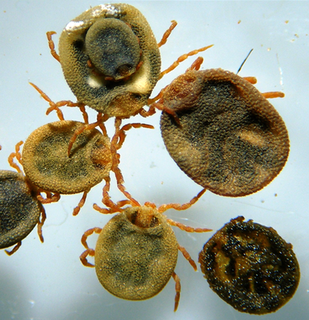
Nuttalliella namaqua is a tick found in southern Africa from Tanzania to Namibia and South Africa, which is placed in its own family, Nuttalliellidae. It can be distinguished from ixodid ticks and argasid ticks by a combination of characteristics including the position of the stigmata, lack of setae, strongly corrugated integument, and form of the fenestrated plates. It is the most basal lineage of ticks.

Ixodiphagus hookeri, the tick wasp, is a chalcid wasp which lays its eggs into ticks. It seems to use a symbiotic bacteria, Wolbachia pipientis, to weaken the tick's immune system.

Ixodes is a genus of hard-bodied ticks. It includes important disease vectors of animals and humans, and some species inject toxins that can cause paralysis. Some ticks in this genus may transmit the pathogenic bacterium Borrelia burgdorferi responsible for causing Lyme disease. Additional organisms that may be transmitted by Ixodes are parasites from the genus Babesia, which cause babesiosis, and bacteria from the related genus Anaplasma, which cause anaplasmosis.

Amblyomma is a genus of hard ticks. Some are disease vectors, for example the Rocky Mountain spotted fever in Brazil or ehrlichiosis in the United States.

Hyalomma is a genus of hard-bodied ticks common in Asia, Europe, and North Africa. They are also found in Southern Africa. The name is derived from Greek: hyalos (ὕαλος) crystal, glass; and omma (oμμα) eye.
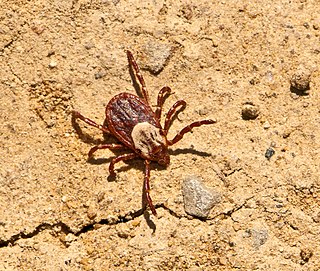
Dermacentor is a genus of ticks in the family Ixodidae, the hard ticks. The genus has a cosmopolitan distribution, with native species on all continents except Australia. Most occur in the Nearctic realm.

Rhipicephalus is a genus of ticks in the family Ixodidae, the hard ticks, consisting of about 74 or 75 species. Most are native to tropical Africa.

Ticks of domestic animals directly cause poor health and loss of production to their hosts. Ticks also transmit numerous kinds of viruses, bacteria, and protozoa between domestic animals. These microbes cause diseases which can be severely debilitating or fatal to domestic animals, and may also affect humans. Ticks are especially important to domestic animals in tropical and subtropical countries, where the warm climate enables many species to flourish. Also, the large populations of wild animals in warm countries provide a reservoir of ticks and infective microbes that spread to domestic animals. Farmers of livestock animals use many methods to control ticks, and related treatments are used to reduce infestation of companion animals.

Hyalomma marginatum is a hard-bodied tick found on birds including the pale crag martin. This tick has been implicated in the transmission of Bahig virus, a pathogenic arbovirus previously thought to be transmitted only by mosquitoes.

Dermacentor circumguttatus is a species of hard tick belonging to the family Ixodidae.

Hyalomma dromedarii is a species of hard-bodied ticks belonging to the family Ixodidae.
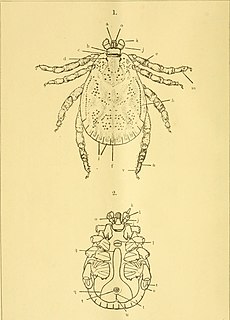
Dermacentor auratus is a hard-bodied tick of the genus Dermacentor. It is found in India, Sri Lanka, Indonesia, and Vietnam. The length from capitulum to middle festoon is 7 mm and maximum breadth at its mid length is 5 mm. Adult has highly ornate scutum, capitulum, and legs. A pair of eyes was present at the level of second coxae. Brown base color markings on the dorsal scutum is the characteristic feature.
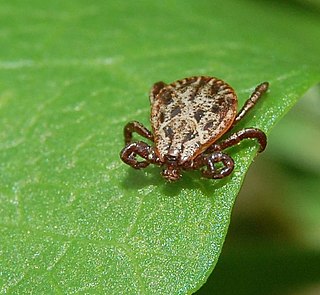
Dermacentor reticulatus, also known as the ornate cow tick, ornate dog tick, meadow tick, and marsh tick, is a species of tick from the family Ixodidae. It is the type species for the genus Dermacentor. D. reticulatus is an ornate tick. The female varies in size from 3.8–4.2 mm (unfed) to 10 mm when engorged after feeding. The unfed male is 4.2–4.8 mm long. D. reticulatus is found in Europe and Western Asia, generally in wooded areas.

The zebra tick or yellow back tick is a species of hard tick. It is common in the Horn of Africa, with a habitat of the Rift Valley and eastward. It feeds upon a wide variety of species, including livestock, wild mammals, and humans, and can be a vector for various pathogens. The adult male has a distinctive black and ivory ornamentation on its scutum.
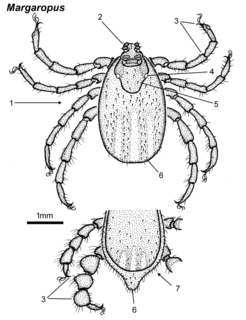
Margaropus is a genus of ticks, characterized as inornate, having eyes, lacking festoons, and with the legs of the male increasing in size from pair I to IV with the segments enlarged, giving them a beaded appearance, from which the genus name was taken, margaritopus signifying beady-legged; the species name memorialized naturalist and entomologist Wilhelm von Winthem.
Margaropus reidi, the Sudanese beady-legged tick, is an ixodid tick that is parasitic on the Northern giraffe It is one of only three species in the genus Margaropus. The type specimens were collected in Liednhom on the south bank of the Jur River, and at Guar, in the Gual-Nyang Forest, Bahr el Ghazal, South Sudan.
Paul Schulze was "the most important German tick taxonomist of the early 20th century." Between 1929 and 1937, he described 19 genera, 17 subgenera, 150 species and 150 subspecies of ixodid ticks. He was essentially an amateur taxonomist, working alone for most of his career, not consulting the major tick collections or collaborating with other tick taxonomists.















